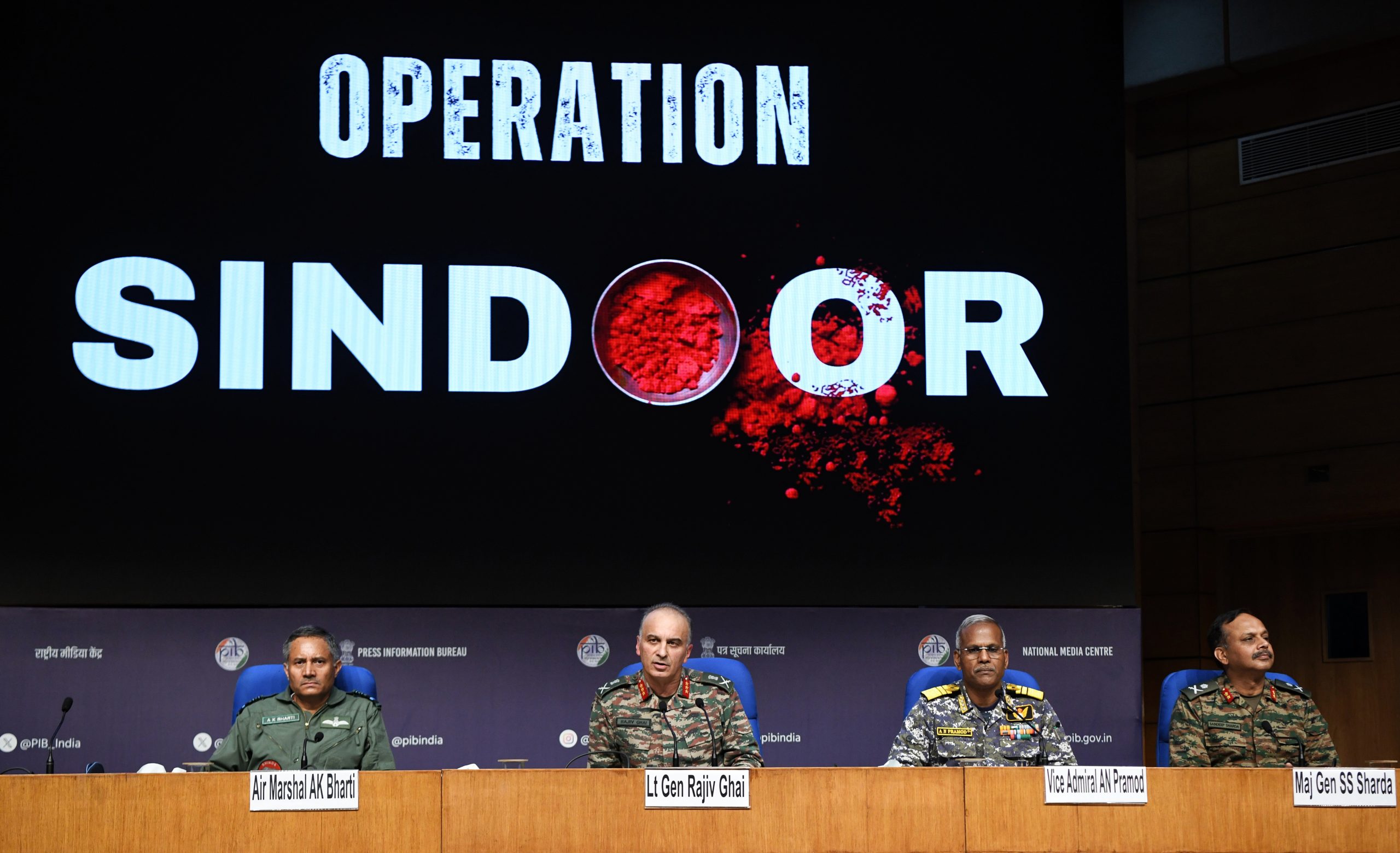On May 7, 2025, India launched Operation Sindoor, a meticulously planned and strategically executed military response that signaled a powerful transformation in the country’s counterterrorism policy. Triggered by the Pahalgam terror attack on April 22, in which 26 civilians, including a Nepali national, were brutally killed, Operation Sindoor was more than just a retaliatory strike — it was a message to the world. India would no longer tolerate cross-border terrorism and would retaliate decisively against any such provocations.
The operation, conducted just two weeks after the Pahalgam tragedy, specifically targeted terrorist infrastructures operated by Jaish-e-Mohammed (JeM), Lashkar-e-Taiba (LeT), and Hizbul Mujahideen (HM) across Pakistan and Pakistan-occupied Kashmir (PoK).

Targets of the Operation: Precision and Planning
Indian forces focused on nine key terrorist camps, ensuring the strikes were precise and confined to enemy targets, thereby avoiding civilian casualties and broader conflict escalation. The camps targeted were:
-
Sawai Nala camp – Muzaffarabad
-
Syedna Bilal camp – Muzaffarabad
-
Gulpur camp – Kotli
-
Barnala camp – Bhimber
-
Abbas camp – Kotli
-
Sarjal camp – Sialkot
-
Mehmoona Joya camp – Sialkot
-
Markaz Taiba camp – Muridke
-
Markaz Subhanallah – Bahawalpur
Each target was selected based on concrete intelligence, with the goal of eliminating militant strongholds while minimizing the risk of broader conflict. This strategic approach showcased India’s maturity in balancing decisive military action with measured escalation.
Global Recognition: Analysts Applaud India’s Strategy
Tom Cooper: Air Superiority and Strategic Dominance
Austrian military historian Tom Cooper described India’s performance as a “clear-cut victory”, highlighting how Pakistan’s deterrence strategy crumbled under India’s sustained and effective offensive.
Key observations from Cooper:
-
Failed Deterrence by Pakistan: Pakistan’s longstanding reliance on nuclear posturing and threats of retaliation was rendered ineffective. India struck back and escalated, yet remained within the bounds of controlled conflict.
-
Lack of Retaliatory Capacity: Pakistan’s eventual request for a ceasefire was seen as a result of depleted ammunition stocks and failed military responses.
-
Operational Superiority: India maintained the upper hand throughout, forcing Islamabad to seek an off-ramp via diplomatic channels.

John Spencer: Calibrated Power and Strategic Doctrine
John Spencer, Chair of Urban Warfare Studies at the Modern War Institute, praised Operation Sindoor as a textbook example of modern deterrence and credited India with reasserting strategic independence and redefining regional engagement norms.
Key takeaways from Spencer’s analysis:
-
New Red Lines Enforced: Terrorist attacks from Pakistani territory will now face direct military consequences.
-
Demonstration of Overwhelming Military Superiority: India showed its ability to strike terror hubs, drone facilities, and even airbases across Pakistan. In contrast, Pakistan failed to penetrate any Indian defense.
-
Restored Deterrence: India’s actions reestablished deterrence by showing its capacity for controlled escalation without falling into the trap of full-scale war.
-
Strategic Sovereignty: India managed the crisis without relying on international mediators, signaling a strong shift toward autonomous security doctrine.
Spencer emphasized that India not only achieved but exceeded its strategic objectives within four days — a feat of exceptional modern warfare.

Jennifer Zeng’s Account: Tactical Precision and Pakistan’s Desperation
International journalist Jennifer Zeng, a member of the International Press Association, provided a detailed narrative of India’s surgical strikes and the unfolding geopolitical response. According to Zeng:
-
India executed a series of highly targeted attacks that dismantled Pakistan’s terror infrastructure, including air defense systems and key military installations.
-
As the strikes continued, Pakistan’s attempts at retaliation were consistently neutralized by India’s S-400 Triumf and other air defense technologies.
-
Facing military degradation, Pakistan’s leadership reached out to the U.S. and Saudi Arabia, pleading for diplomatic intervention to avoid a complete breakdown.
-
Zeng’s timeline also tracks the psychological and strategic breakdown within Pakistan’s military leadership, culminating in an official ceasefire request.
Chronology of the Conflict: May 7–10, 2025
May 7: The Offensive Begins
-
India launches a massive airstrike using Rafale fighter jets and BrahMos missiles.
-
Multiple terror camps linked to Jaish-e-Mohammed and Lashkar-e-Taiba are destroyed.
-
Pakistan’s proxy network receives a devastating blow.
May 8: Strategic Systems Neutralized
-
Indian forces destroy HQ-16 air defense systems in Lahore.
-
This exposes Pakistan’s over-reliance on imported military technology and weakens its retaliatory capabilities.
May 9: Turning Point of the Conflict
-
Indian jets bomb strategic airbases like Nur Khan and Rafiqui, further crippling Pakistan’s air capabilities.
-
Pakistan retaliates with drones, missiles, and jets — all of which are intercepted by India’s air defense systems.
-
Six incoming missiles are neutralized, avoiding a potential catastrophe.
-
Pakistan’s narrative about damage inflicted on India is dismissed as "propaganda."
-
General Asim Munir reaches out to U.S. Secretary Marco Rubio, Vice President JD Vance, and Saudi Foreign Minister, pleading for a diplomatic solution.
May 10: Ceasefire
-
Pakistan’s Director General of Military Operations (DGMO) requests a ceasefire.
-
A “face-saving off-ramp” is proposed and accepted.
-
Ceasefire takes effect at 5:00 PM IST, brokered by international actors.
India’s Strategic Shift and Regional Recalibration
Operation Sindoor stands as a watershed moment in India’s modern military history — a campaign defined by precision strikes, strategic clarity, and measured escalation. What sets this operation apart is not just the scale or swiftness, but the message it delivered:
India will no longer accept cross-border terrorism as a norm.
India succeeded in:
-
Dismantling key terror infrastructures
-
Crippling Pakistan’s air defense and military bases
-
Restoring deterrence without triggering a full-scale war
-
Avoiding civilian casualties
-
Asserting independent military doctrine
As analysts Tom Cooper, John Spencer, and Jennifer Zeng note, India has rewritten the rules of engagement in the region. Strategic restraint no longer equates to inaction. Instead, India has demonstrated the ability to deliver lawful, powerful, and proportionate responses to threats — ensuring its sovereignty, security, and global standing.
Analysis credits: Tom Cooper and John Spencer
With inputs from PIB
Image Source: Multiple agencies
© Copyright 2025. All Rights Reserved Powered by Vygr Media.



















